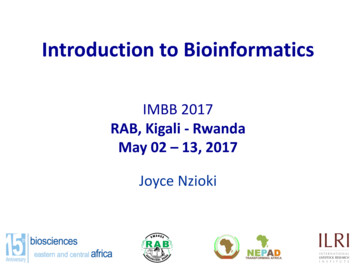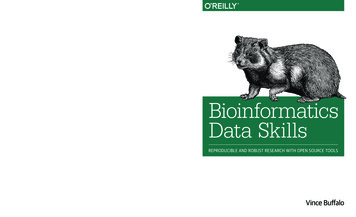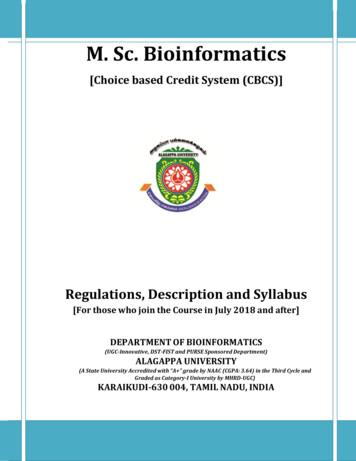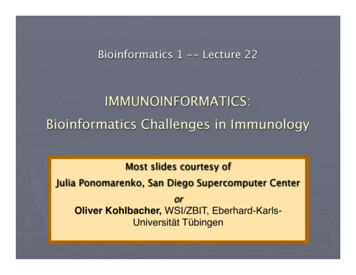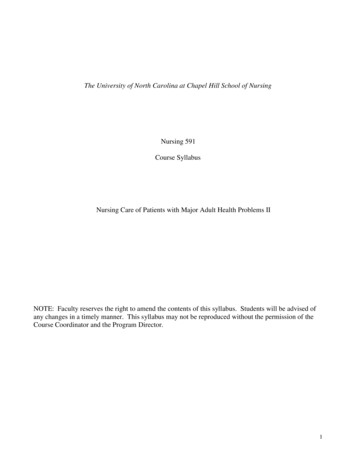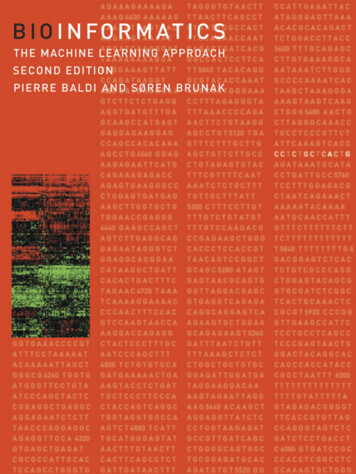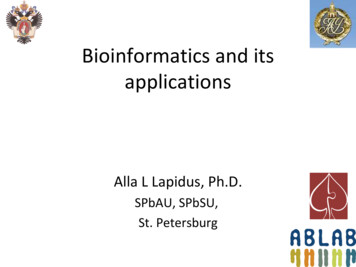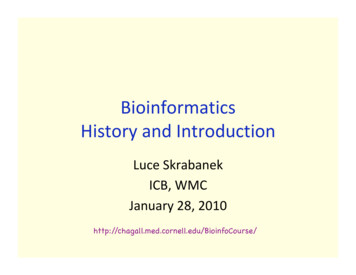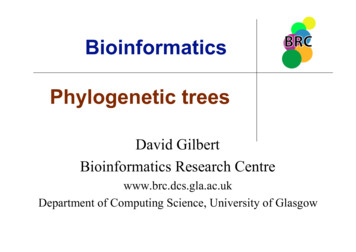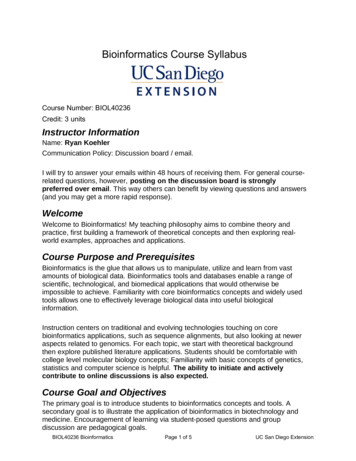
Transcription
Bioinformatics Course SyllabusCourse Number: BIOL40236Credit: 3 unitsInstructor InformationName: Ryan KoehlerCommunication Policy: Discussion board / email.I will try to answer your emails within 48 hours of receiving them. For general courserelated questions, however, posting on the discussion board is stronglypreferred over email. This way others can benefit by viewing questions and answers(and you may get a more rapid response).WelcomeWelcome to Bioinformatics! My teaching philosophy aims to combine theory andpractice, first building a framework of theoretical concepts and then exploring realworld examples, approaches and applications.Course Purpose and PrerequisitesBioinformatics is the glue that allows us to manipulate, utilize and learn from vastamounts of biological data. Bioinformatics tools and databases enable a range ofscientific, technological, and biomedical applications that would otherwise beimpossible to achieve. Familiarity with core bioinformatics concepts and widely usedtools allows one to effectively leverage biological data into useful biologicalinformation.Instruction centers on traditional and evolving technologies touching on corebioinformatics applications, such as sequence alignments, but also looking at neweraspects related to genomics. For each topic, we start with theoretical backgroundthen explore published literature applications. Students should be comfortable withcollege level molecular biology concepts; Familiarity with basic concepts of genetics,statistics and computer science is helpful. The ability to initiate and activelycontribute to online discussions is also expected.Course Goal and ObjectivesThe primary goal is to introduce students to bioinformatics concepts and tools. Asecondary goal is to illustrate the application of bioinformatics in biotechnology andmedicine. Encouragement of learning via student-posed questions and groupdiscussion are pedagogical goals.BIOL40236 BioinformaticsPage 1 of 5UC San Diego Extension
Learning ObjectivesBy the end of this course, the student will be able to: Describe bioinformatics in both theoretical and practical terms, including adescription of the domains where bioinformatics is particularly useful and alist of some of the more widely used algorithms, tools, and databases. Understand what problems key algorithms are designed to solve and listseveral software implementations (i.e. tools) that employ these algorithmsto solve these problems. For example, sequence alignment can revealbiological similarities and BLAST is one tool that facilitates this task. Practically appreciate the utility of resources like NCBI / Entrez, the UCSCgenome browser, EBI / EMBL, Uniprot, BLAST, etc Be able to take one piece of biological information and expand on this tobuild a more complete picture of what is known about the systems wherethis information is relevant. For example, given a gene name, or a DNAsequence, etc, one should be able to use appropriate databases andsearch tools to build a coherent picture to answer such questions as: Whatgenes are related to this and in what organisms to they occur? Whatvariations and / or mutations are known? Are these associated withdisease? Are structures of the derived protein known? Are there knownchemicals / drugs that interact with this protein? Etc, etc, etc.Course MaterialsAll required literature for assigned reading consists of open-access articles (freeon the web). These papers (pdf files and/or links) will also be posted on Canvas.Also, we do not have a required textbook. “Bioinformatics for Dummies” used tobe a reasonable option to see step-by-step use of various tools. This is still anoption, though the book is a bit dated so some web interfaces will havechanged.Course OverviewThis course has 9 weekly sessions. Each week's session consist of slides,assigned reading of scientific literature, a quiz / work assignment, andparticipation on the discussion board. The first and last weeks have no quiz. Inaddition, a summary report illustrating the application of bioinformatics tocharacterize some target of interest comprises the course project.Weekly sessions follow this outline:1: Introduction, Background & Examples2: Fundamentals: Molecular Biology & Computer Science3: Information & Literature4: Sequence searches5: Genomes and GenomicsBioinformaticspage 2 of 5UC San Diego Extension
6: Genotype / Phenotype7: Comparative Genomics8: Gene products: Proteins, RNAs9: Integration & SummaryRequirementsIn order to satisfy course requirements, students must participate in discussions,complete all course assignments on time, and use graduate level writing /presentation for all written assignments. Late assignments (anything posted afterthe due date) will be down graded for each day late unless due to a verifiablemedical or family emergency. Assignments sent with the wrong namingconvention or in the wrong format will be considered late until they are sentcorrectly.In general, the performance criteria for an A grade for assignments is listedbelow: Demonstrates a high level understanding of issues, including complexities. Is well focused and sequenced. Has a clear sense of purpose. Thoughtsare clearly developed and easily understandable. Critically evaluates the topic beyond what is stated in readings, research,and discussions. Makes connections. Expresses views clearly. Provides specific examples, details, illustrations,anecdotes, etc. to support positions taken. Does more than repeat what the text says or what was said in class.Draws out additional important implications. Shows originality of thought. Uses proper citations for resources. Uses organizers: table of contents, topic headings, etc. Has no punctuation, grammar, spelling errors. Style, formatting, andappearance add to quality of final product.Written assignments MUST be sent as a PDF attachment! No exceptions.Assignments/Quizzes/Discussion Board ParticipationDiscussion Board Participation—20 pointsRegular presence in blackboard discussions. Substantial contributions areexpected to gain full points. This may include taking a leadership role in weeklyonline discussions, such as pointing out key literature findings and directingfollow up questions, pointing to useful web resources, etc.Bioinformaticspage 3 of 5UC San Diego Extension
Assignment / Quiz Grades—40 pointsThese will be made accessible (in blackboard) on or before Sunday and must becompleted by the following Wednesday. You should receive feedback within afew days, always before the next class.Class Project—40 pointsFor this, you will choose some biological molecule(s) of interest and provide acomprehensive picture of what biological information is known (and unknown)about this system, along with an analysis of why this is important and relevant tosome application(s) in medicine, biotechnology, etc. For this class, a goodbiological target would be a gene / protein system that is relevant to someapplication(s) you are interested in. Your chosen target (e.g. some gene) willserve as your example test-case for each week's quiz assignment. In this wayyou will collect relevant information for your final project as you proceed throughthe course.The project should be doubly formatted as both a high-level graphic presentation(i.e. slides), and as a more comprehensive written report, including methods (i.e.where did you get the data and how did you process it?), references, etc. Ideally,the biological target you choose can be explored in light of each class topic wecover and then written up. Progress on your projects should be regularly sharedon the discussion board, as this will both help to keep you on track as well asallow others to learn from the multiple different results we can expect for differenttarget systems.GradesNo late assignments or quizzes are accepted.Grades are based on points and the letter grades are given as follows:A 97-100A94-96A90-93B 87-89B84-86B80-83C 77-79C74-76C70-73D 67-69D65-66F0-64Bioinformaticspage 4 of 5UC San Diego Extension
You may check your grade anytime by clicking Course Tools and then My Grades. Thiswill show you the points you have earned so far in this course.About Discussion Board ParticipationA regular presence is expected in blackboard discussions, with substantial contributionsabout class topics and discussion questions expected. What this means, essentially, iscoming into blackboard regularly, reading what others are discussing and contributing toexisting topic threads or initiating your own thread. So what is contribution/participation?Here are some ideas: start a discussion on blackboard (add a thread) respond thoughtfully to a topic provide links and resources related to the topic pose a though-provoking question related to the topic provide pros and cons thoughtfully rebut another person’s comments make you postings in a timely mannerIn grading, quality and quantity are considered. Regular contributions that add to theknowledge base of other students, links to additional resources, and providing substantivefood for thought get points. If you don’t know a lot (yet!) about the topics, feel free toshare some questions to others and/or search the Internet and share what you find withthe class. Think about the logic behind this. We can sometimes learn just as much fromthe person sitting next to you (even in the virtual classroom) as you can from theinstructor. We are all here to learn.About Assignments/QuizzesThe quizzes must be submitted by Wednesday of the week assigned. Quizzes will bemade visible the proceeding Sunday (i.e. you have at least three days to view andcomplete each quiz). Plan ahead and give yourself plenty of time to complete it. Thesequizzes are based upon the lesson, the readings, and also your own independentinvestigation (i.e. internet searches and resources). You may only attempt the quiz once.About the Course EvaluationThis is an anonymous course evaluation that is collected by UC San Diego Extension. Iexpect you to fill it out as a part of this course. I use the feedback to improve the nextoffering of this course.Student ResourcesOn any blackboard screen, there are tabs across the top and one is called the StudentTab. There is information on how to get started as a student and who to contact if youencounter any problems. There are also videos and written instructions on how to dosome of the most common things in blackboard.Another one of these tabs is called FAQ (Frequently Asked Questions). If you click on theStudents Category (on the left), you can find step-by-step directions for everything fromsending email to uploading your assignments to posting a reply on the discussion board.Bioinformaticspage 5 of 5UC San Diego Extension
Bioinformatics is the glue that allows us to manipulate, utilize and learn from vast amounts of biological data. Bioinformatics tools and databases enable a range of scientific, technological, and biomedical applications that would otherwise be impossible to achieve. Familiarity with core
